France 2024: Part 2
- richardafontaine
- Nov 13, 2024
- 24 min read
Updated: Aug 23
The vagabonds continue to explore the regions of France.
Normandy

Caen
Our first stop is the largest town in the area. It is a college town; students predominate the center city which is largely pleasant old white limestone structures. We take a walk and stop at a small corner bar that sports an impressive beer selection. The owner talks with us about French politics.
The next day is spent at the Caen-Normandy Memorial Museum. It is a huge, new building with exhibits, graphs, films, recordings and memorabilia that cover the events of 1939 to 1945 in both Europe and the Pacific, with special emphasis on the Battle of Normandy. It also covers the Cold War aftermath of WWII with focus on the dozen or more smaller wars across the world from the late 40’s to the present with emphasis on the division of Berlin. Finally, there is a temporary exhibit that focuses on the United States in the 1920’s and 30’s in an attempt to describe the mindset of the soldiers who grew up in that period and fought WWII.

There is a lot to see and read; we feel overwhelmed when we leave. The tone is a bit depressing due to the nature of the subject matter and the war carnage: 21 million Soviets killed, 7 million Germans, 300,000 Americans, et al. The presentation also feels somewhat sterile with no particular judgements implied about the Nazi’s, Japanese or Soviets actions.
We contrast this museum, and the others we visit in Normandy, with the New Orleans WWII / D-Day Museum. The NO Museum seems more intimate, with more stories about people, maps of troop movements, the buildup to war production, and more equipment displays. But the French museums have the advantage of being in the place where the battles occurred, where you can see the landing areas, the topography, and understand the distances between events.
D-Day Beaches and the Battle of Normandy:
We take a guided day tour of the beaches. The scale of the Allied invasion is staggering – the largest air, sea and land operation in history:
24,000 paratroopers in 1,200 planes jump south of the landing beaches at night just before the invasion in order to control key bridges and roads
2,200 aircraft bomb northern Normandy at the beginning of the invasion to soften the Nazi positions (the Germans had only 570 aircraft in Normandy)
7,000 craft in the invasion fleet cross the English Channel manned by 190,000 navy personnel
160,000 troops from Britain, USA, Canada, and a few from France and other Allies land on the beaches (73,000 were Americans).
Within a week, another 170,000 troops and 50,000 vehicles arrive in Normandy. By the end of June, a total of 850,000 troops and 150,000 vehicles land. By the end of August, 2 million troops land.
The Germans have 50,000 troops and 170 coastal guns protecting northern Normandy.
The Battle of Normandy costs 225,000 casualties (73,000 killed; 154,000 wounded) in addition 15 to 20,000 French civilians die. The Germans have 240,000 casualties and 200,000 captured.
The sites of the invasion are equally awe-inspiring:
Ste-Mere Englise is the nearest village to Utah Beach (about 5 km). Paratroopers surround the village during the pre-dawn hours of D-Day so it is the first liberated village in Normandy. It now houses a four-building museum dedicated to the daring aerial landings on D-Day. The museum starts with an entry onto a simulated paratrooper aircraft on its way to the drop zone. You walk past the pilots and the paratroopers in their gear seated along benches on the side of the plane; out of the windows you see other planes and far below is the landscape of Normandy. You feel like you were there. Other sites in the museum are films about the training of the paratroopers, iterations of their jump uniforms and gear (this was the first war in which airborne troops were used), and the planes / gliders used. Well done.

Utah Beach is a wide (8 km), crescent-shaped beach with high bluffs along its south side where the Nazi troops are stationed. (Luckily, most were conscripted Czechs, Poles and Russians whose motivation to fight is limited.) Bombers soften up the Nazi defenses before the Allied troops land. The bombers are supposed to stay above the clouds and strafe the defensive positions in a north-to-south flight path from the ocean to the interior. But at Utah Beach the aircraft do not follow orders; they fly below the clouds and parallel to the coast. Thereby they neutralize an estimated 80% of the defensive positions. The landing troops capture the beach in 45 minutes with relatively light casualties as a result.

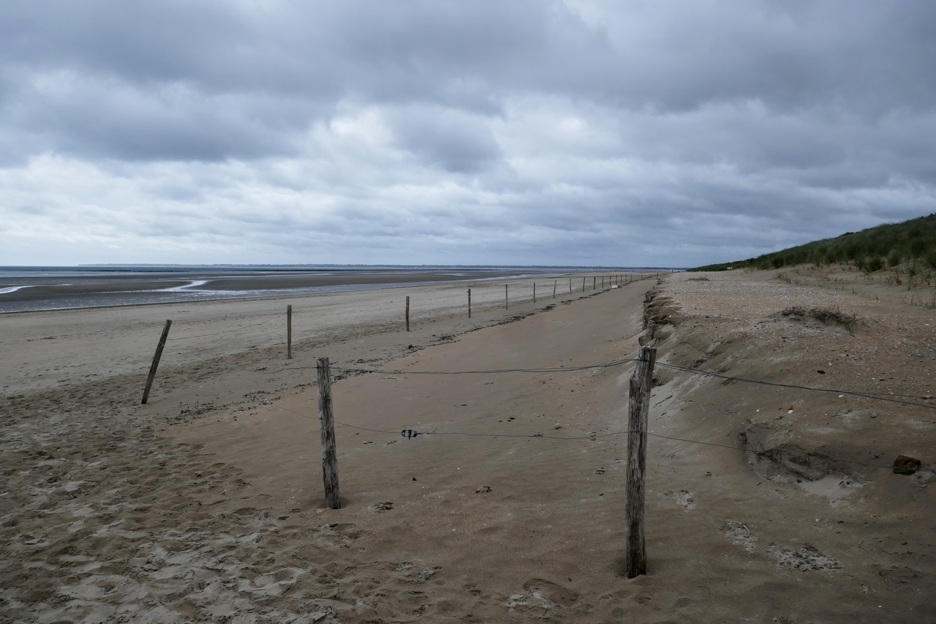
The Pointe du Hoc fortification is between Utah and Omaha Beaches. Here 225 U.S. Rangers scale a sheer 30 meter cliff in 25 minutes to take a key German defensive position that consists of three concrete reinforced bunkers and six huge cannons (from WWI) that can hurl 40 kg shells 12 miles. As it turned out, right before the invasion the Germans move the guns inland to protect them, and replace them with wooden replicas! And they were so confident of their position that they turn most of their smaller guns inland to where they assume an attack would originate. The Rangers still find one of the big guns a km inland, and destroyed it.


Omaha Beach, smaller than Utah, is also lined with high bluffs. The bombers are not very effective here in softening the defenses (they follow orders and fly over the bluffs at a 90 degree angle so most of the munitions miss their targets). 500 Germans manning 11 gun nests pummel the beach all day. Accordingly, this is the bloodiest of the D-Day battles with 4,000 US troops killed.

The American Cemetery near Omaha Beach has 10,000 graves marked in neat rows with white marble crosses (or Stars of David), much like Arlington National Cemetery. There is a large memorial with reliefs of the Battle of Normandy and the re-taking of Europe. The site is immaculately maintained. The whole environment is one of solemn reverence.


The largest of the six German Cemeteries in Normandy with 21,000 graves is between Utah and Omaha Beaches. The soldiers are buried 2 deep with small clay markers listing the names and ranks. In the center is a circular mound with a cross and a grieving Mary and Joseph carved in dark basalt rock.

Bayeux
This town of 12.500 people is filled with history. It has been inhabited since pre-Roman times (although there are few remaining traces) but is mostly a tourist town now with a long main street of shops selling all manner of foods, clothing and souvenirs.
The Bayeux Tapestry
In Bayeux is a memorial to a different, earlier war – the Battle of Hastings in 1066 where 7,000 troops under William of Normandy met an equal size force under Harold, King of England. Harold is killed in the battle. William (the Conqueror) takes control of England.
The episode is memorialized on a tapestry of wool embroidered on linen that is 70 meters long and 1 meter high. It was made as a propaganda piece by Bishop Odo (William’s half-brother) to communicate the justice of Harold’s defeat: In pictures it tells the story of Edward, the previous King of England, who had no direct heir so sends his son-in-law, Harold to tell Edward’s cousin William that old king selects William to succeed him. Harold is captured on the way; William frees him; Harold distinguishes himself in battle (at Mont St Michel) aiding William; and William gets Harold to swear that he will support William as Edward’s successor. Instead, upon returning to England, Harold seizes the throne upon Edward’s death. This treachery explains the reason for Harold’s defeat - according to the tapestry.


The tapestry is in remarkable condition for a piece that is almost 1,000 years old. Other such works were made with gold or silver thread so were melted over time to harvest these precious metals. Being of wool and linen, this tapestry wasn’t worth destroying! It was hung annually in the Bayeux Cathedral for many centuries, yet still remains vibrant and whole.
The Cathedral
The centerpiece of Bayeux is the cathedral, built in 1077 by Bishop Odo (who commissioned the tapestry). It is as big as Notre Dame in Paris. The lower section is classic Norman / Romanesque architecture and the upper is Gothic with soaring ceilings and flying buttresses. William the Conqueror himself attended the opening services.

Since the Revolution, the Government of France owns and maintains all of the major cathedrals in the country. This is fortunate as small towns like Bayeux could not afford the upkeep.
Lace and Ceramics
Bayeux is also known (mostly from bygone days) as a center for the creation of delicate lace (mostly in black) and also ceramics. Most buildings and street signs are of a white, oval ceramic with black letter design.
Mortain
We begin our 2 ½ week pet-sit in southwest Normandy. The owners, Gail and David are professors at an English college who retired here 8 years ago. At home with us are an older cat (that sleeps all day and hunts outside all night) and an 11 year old short hair, medium-large size hunting dog named Laszlo. Mary walks him for 2 to 3 hours per day. He carries a long, lime green plastic stick along and delights in chasing it. He is devoted to Mary.
Mortain is the site of an important WWII battle in early August, 1944. The Americans liberate the town on August 3 and set up field operations on Hill 314 above the town (less than a 30 minute walk due east of our house). From there the soldiers have a clear view of the surrounding countryside for miles to the east and south.

However, Hitler orders his southern Normandy troops to drive west in an attempt to cut off General Patton’s tank division which is liberating Brittany. On August 7, four divisions of experienced Nazi SS Panzer troops, 12,000 men with 185 heavy tanks and assault guns, surround Hill 314 and re-take Mortain. Some 800 Americans of “Old Hickory” division on the Hill are trapped for 6 days with no reinforcement of food, medicine or ammunition, depending on a single battery-powered radio to direct cannon-fire from the rear to ward off the enemy from overrunning their Hill. Half of them are killed or sustained serious injuries before another American battalion can arrive. But they retain their position on the Hill. This is the last Nazi counteroffensive in the Battle of Normandy. August 12th is highly celebrated here with reenactments of the battle, parades, speeches and films.
Mont St. Michel
We do a day trip to the island of Mont St. Michel on the border of Normandy and Brittany. The circular island is a kilometer from shore at the mouth of the Couesnon River and is protected by some of the highest (~ 14 meter) tides and swiftest currents in Europe. At low tide, the island is approachable over a sandy mudflat that can turn to quicksand as the tide starts to come in (this is where Harold rescued a group of Norman knights as depicted in the Bayeux Tapestry). Now there is a pedestrian bridge to the island, but the tides still rule the landscape below and can at times flood the lower levels of the village.


The island is about 17 acres in size and was occupied by religious hermits as early as the 500’s. In 708, the local bishop, St. Aubert, heard the voice of St. Michael the Archangel three times in his dreams commanding him to build a sanctuary high up on the island, which he did. In 966, the Benedictine monks created an abbey on the island and built a church trying to reach as close to heaven as possible. About 50 monks lived here. It became a place for pilgrimage and an intellectual center. Beginning in the 1200’s the buildings were expanded with the granite for these structures brought by sea from a quarry over 20 miles distant. 4 immense crypts were built to create a platform for supporting a large Romanesque church.


Cloisters, a refectory, a guest hall, a three-level Merveille (“marvel”) were added. Eventually, rampart fortifications were built to protect the island from assault. It was an immense building project evolving over centuries to create a medieval skyscraper, built on a rock and crowned with a gilded statue of St. Michael. Over the centuries the abbey gained power and wealth. It was a stronghold of the French in the Hundred Years War.
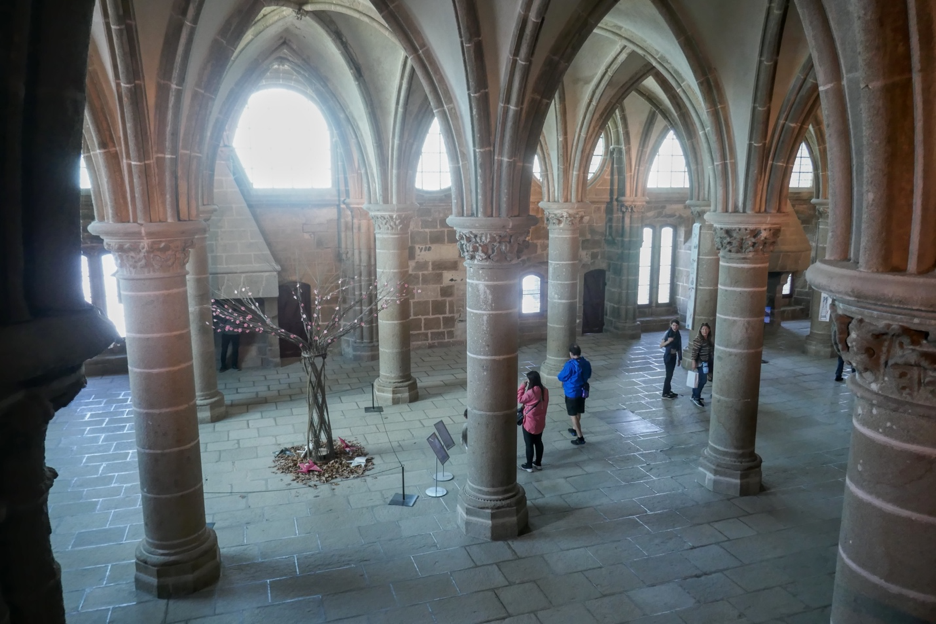
The small village at the base of the island is now a touristic haven with little trinket shops and mediocre, overpriced restaurants. One famous establishment is La Mere Poulard which was opened by Annette Poulard in1888. She specialized in whipping up a thick, souffle-style egg omelet over a wood-buring hearth for hungry pilgrims. The restaurant still makes these omelets in her traditional manner.

The shore-land adjacent to Mont St Michel Bay is composed of miles of salt marshes stretching into both Normandy (east) and Brittany (west). Some of the land is polder – land reclaimed from the sea by specially built dykes. These grasslands are periodically drenched by seawater and blown dry by salty winds from the sea; only saline-tolerant plants grow here. The pastures are ideal, though, for sheep who develop a unique flavor grazing on the salt marsh plants. We see hundreds of these sheep as we walk to and from the island.

Reims
Reims (pronounced “rances”) is the largest city in the champagne region and the site of the cathedral where some 29 French kings were coronated between 1027 and 1825. Legend says the city was founded 2,000 years ago by Remus, brother of Romulus the founder of Rome.
Cathedral of Notre Dame
A church has been on this site since 314, and the cathedral is one of Reims’ most important buildings. Legend says this is where Clovis, king of the Franks, was baptized in 498 by St Remi. Legend says that a dove sent by God brought St. Remi a vial of oil to anoint Clovis, thereby creating a bond between the king and God. The vial was stored in a Holy Ampulla, and used for future coronations – thereby making Reims the desired place for coronations, allowing the king to claim that he rules by Divine Right.


Champagne Houses
We tour Veuve Clicquot, the house perhaps most familiar to Americans. It consists of 30 minutes in the chalk cellars describing (poorly) the process of making champagne and the history of the house, and 30 minutes tasting two rose’s (vintage and non-vintage). Then we were unceremoniously asked to leave the tasting room to see the sales room. We have never before been kicked out of a tasting before being done – until today. Rude. Better to buy a bottle or two and enjoy them on your own schedule than be subject to this commercialism.

We also had a reservation at Taittinger. However when we arrived at their cellars (which are advertised as amazing, holding 3 million bottles) we find that the tasting is held at another location which we can’t find.
Our discovery prize, though, is Martel, just two blocks from our gite. It is a smallish location but the service is very good. We enter and declare that we want to buy a few bottles. The helpful young clerk carefully describes his wines in detail and pours us tastings. We find a rose and a meunier-based champagne that are delightful.

Provence
Provence in southeastern France has an abundance of our favorites: world-class wineries; lovely little market villages; impressive natural scenery; fields of lavender in their full, violet glory and fragrant aroma, golden, bright sunflowers along the roadways; historical structures; tasty food; and comfortable living.
The Wineries
Domaine de l’Amauve in Seguret is an unassuming place – a farmhouse really. There is no one there but a phone number is posted so we call. Christian Voeux answers; he is nearby in the vineyard and walks right over. He is an easy-going fellow with a quick, winning smile and a humble self-image. He became interested in winemaking by watching his grandfather who owned the vineyards until the early 1960’s. Eventually, Christian became winemaker at Chateau Mout-Redon, one of the largest wineries in Chateauneuf du Pape. Now he focuses on his own vineyard.

Christian’s philosophy is to make fresh, fruit-driven wines from Grenache grapes with lower alcohol (14 to 15%), a good core of acid and soft tannins at the end. To accomplish this, he drops a lot of fruit (to concentrate the harvest) and picks early (~ August). He uses a combination of stainless steel and older barrels for fermentation, and prefers to ferment for a longer time at lower temperatures. There is no need to hurry, he says, quality wine is all about the grapes and vineyard practices. He likes being his own boss and making wine the way he thinks it should be made.

Gigondas is another small village set on a hill overlooking the Rhone valley to the west. It is famous for its grenache / syrah blends. We stop at a wine shop that represents dozens of local wineries and try a half-dozen delicious samples.

Chateauneuf du Pape is ancient village which gained fame in the early 1300’s when Pope John XXII built a summer residence and defensive fortress here, then cultivated the local wines. The unique conditions in which the grapes grow are responsible for their distinctive quality. The vineyard terroir is full of stones (called galets roulés) which heat up from the sunshine during the day and then slowly release their heat during the night, so that the vines never get too cold. The stones can run up to 4 meters deep, forcing the vines to struggle for water and giving the grapes a minerality. The mistral wind that blows from the north keeps away insects and pests, meaning no artificial pesticides are required. The standard cuvee is GSM: Grenache, Syrah and Mourvedre (a grape which is known in Spain as Monastrell).

The village is small (population 2,100) and the streets are very narrow and twisty. But on the night we arrive there is a “La Blanche des Papes” party. It is a high-end celebration with multiple DJ, fancy sound and light systems, and sectional seating across a three or four acre site. The special twist is the requirement for everyone to wear white to gain entry. There are perhaps a thousand 30-somethings in the crowd, dancing, drinking, talking and looking for love. We find a spot on the street just above the party with a great view; just as well since we don’t have white outfits.
Chateau Mont-Redon is just outside of the village. The winery was founded 100 years ago and is still owned and operated by the family Abeille-Fabre. They purchased and planted vines on “the plateau” where the Rhone River once flowed. Our tour guide, Anton, carefully shows us the sophisticated, computer-controlled equipment used for destemming, sorting and fermenting the grapes. Interestingly, the facility is made mostly of concrete – there is no traditional cave. Proper temperature and humidity are maintained by a natural pool of water flowing in the building. The hot weather here (the temperature can rise to the mid-30’s (90’s F) during the summer, and can drop to -20 (0 F) for periods in the winter) produces grapes with relatively high sugar, so care must be taken to avoid high-alcohol wines. Care must also be taken to retain acidity, so malolactic (secondary) fermentation is never used as it lowers acidity.

Domain du Vieux Telegraph in Bedarrides, is nearby. This famous winery was established by the Brunier family over 125 years and 6 generations ago. We taste a half-dozen of their wines including a 2021 CDP and a 2010 CDP. All are well integrated with soft tannins.

The Village Markets
Many Provence villages host large weekly outdoor markets. Dozens and dozens of stalls crowd virtually every street. There are all of the usual wares: meats, cheeses, breads, olives, vegetables, prepared hot foods, and lots of clothing. But also paintings and artwork, knives, wooden kitchen utensils, antique furniture, jewelry and other specialty items. Hundreds of people seek out treasures.
Our favorite markets are in Nyons, St. Remy de Provence, and Ile-sur-la-Sorgue.

The Scenery
The small, out of the way village of Crestet is built on a tall, rocky peak overlooking the Rhone valley. The view to the eastern mountains (1,000 to 2,000 meters high) is impressive. The village architecture has a Roman feel and all of the buildings and steep streets are made of rocks.


Another, even smaller village built of rocks with gorgeous view of the Dentelles de Montmirail mountains is Suzette.

Eygaueres is a picture-postcard hilltop village in the valley of the Alpilles en Provence mountains with a commanding and beautiful view over the valley. The buildings of the village are constructed of rough, sun-bleached white limestone with classic architecture. Even though it is sunny and hot (90-some degrees) like all of Provence there is a light breeze keeping it comfortable.
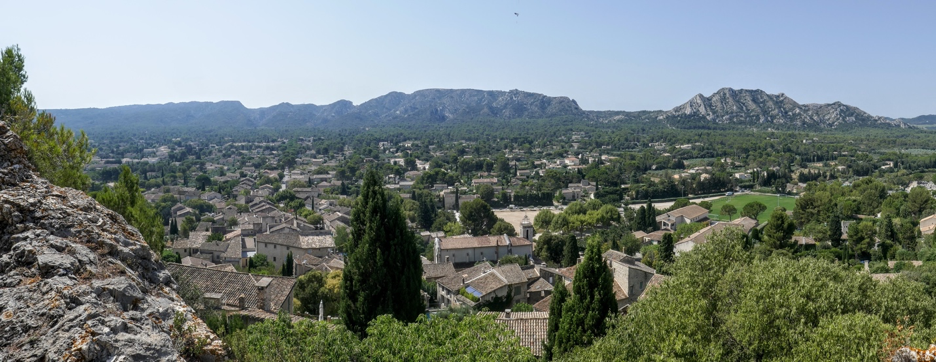
Historical Places
Pont du Gard is one of the best surviving examples of a Roman aqueduct. Built 2,000 years ago, it brought water from a spring to the thriving city of Nimes. Most of the aqueduct is at ground level or underground channeling water along a meandering 50km path around the hills between the spring source and Nimes. However, one 300 meter section spans the River Gard. It is here that the Romans built a 50 meter tall, three tiered arched bridge to carry the water. It is a marvel of engineering, built of carefully cut limestone blocks that fit together without mortar, held in place by their trapezoid shape and sheer weight.

The water channel on the top of the pont is 1 ½ meter wide by 2 meter tall. It was covered during use with rock sheets to keep the water clean.

The pont took 5 years to build. It remained in service for almost 500 years before the barbarians from the northeast took over the territory. Even then the pont was valued as the only bridge over the river in this area, so although water no longer flowed over it, the pont’s stones were not dismantled as building material.
The slope of the aqueduct is likewise amazing; there is only a 12 meter slope between the source water and Nimes – an average of 24 cm per km. It is difficult to imagine how the Roman engineers could even measure and consistently build that small drop over such a long distance. But they did and the water flowed simply by gravity; the Romans didn’t have large-scale pumps.
Arles was founded in 500 BC. It has a deep Roman history with ruins of a large amphitheater, arena, monument and baths, as well as churches from the 1100’s and city walls.
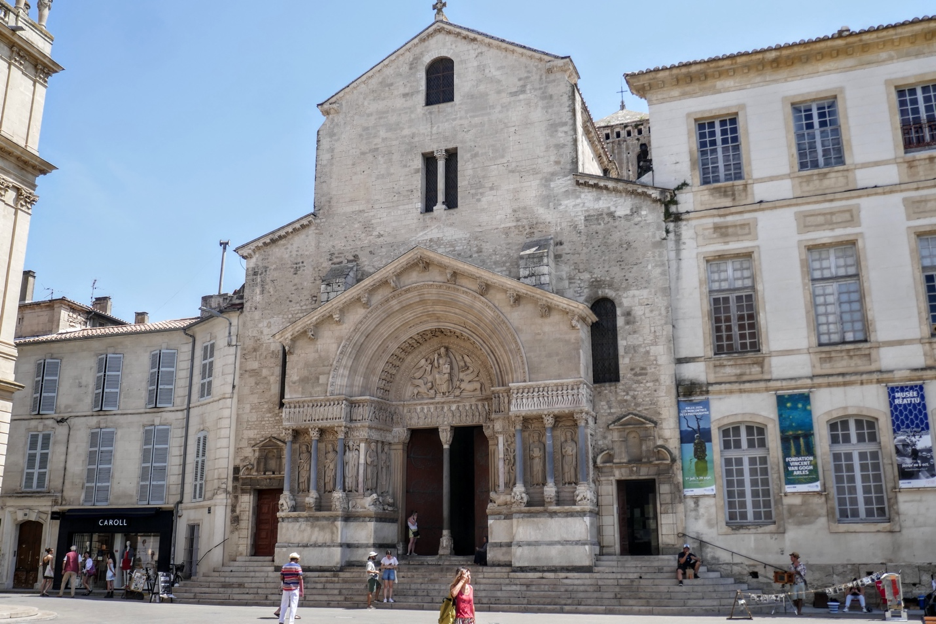
The traditional Roman arena modeled after the Colosseum in Rome seated 20,000 spectators in 34 levels of seats at the gladiator games.
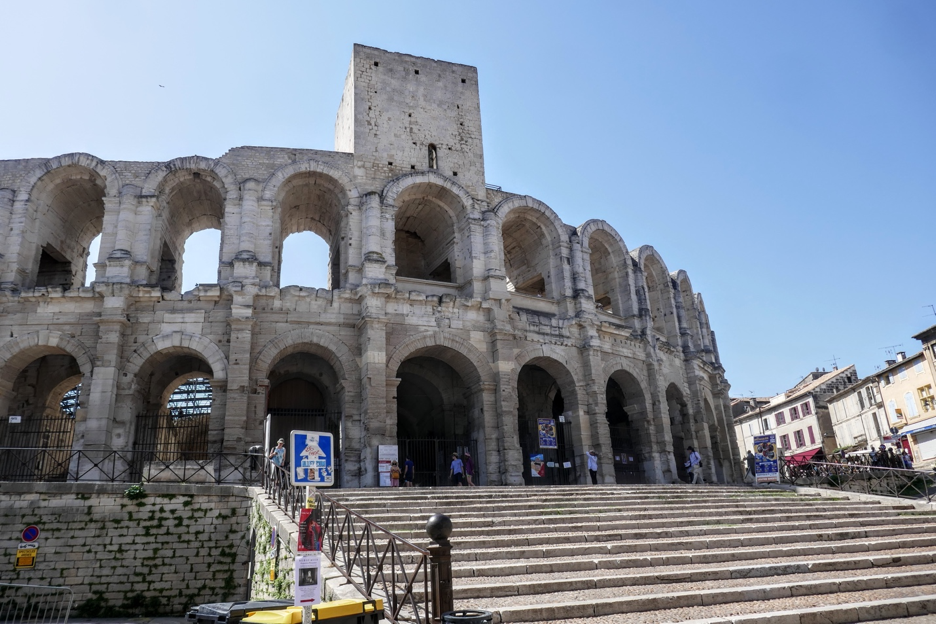

The Roman amphitheater is adjacent, completed about 12 BC. It seated 10,000 in 33 rows of seats on three levels. They are supported by 27 arches radiating behind the seats. The stage wall was supported by 100 tall columns.
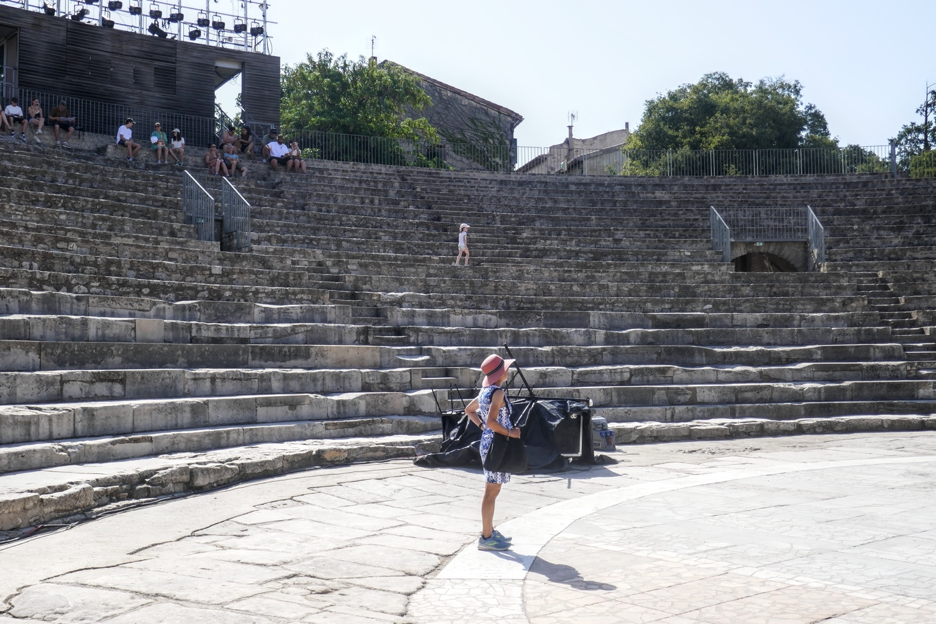
Place de la Republicque square features a tall, lion-themed obelisk that use to be at Arles’s Roman Circus.

Vincent van Gogh settled here in 1888, coming from Paris. He was inspired by what he found, and roamed the countryside painting outdoors driven by the brilliant sun to paint in ever-brighter colors. There are plaques / easels set up at various points in Arles to mark where van Gogh painted.

The castle of Les Baux lies 200 meters atop one of the peaks of the Alpilles mountains. This citadel has existed since 960, much of it cut into the rockface. The Lords of Baux were fierce warriors who controlled 79 towns and strongholds across southern Provence. But in 1426 the last lord of Baux, Alix, died and the castle and its lands were incorporated into the County of Provence which became part of the kingdom of France. The fortress was destroyed.

Today Les Baux is a touristic town where you can wander through the narrow stone streets of the lower town, past the several ancient stone chapels, follow upward to the castle remains, and share the magnificent view of the valley from the windblown cliffs and towers.
Avignon, one of the larger towns in Provence, is surrounded by an impressive and largely in-tact wall with many portals.

The streets are narrow with a medieval-style layout, many with ancient cobblestones. Most are pedestrian-only passages.

The highlight of the town is the Papal Palace (Palais des Papes). It is one of the largest medieval gothic buildings in Europe. It is surrounded by a very large plaza that was the site of a forum in older, Roman days. Although there is very little furniture, the scale of the rooms and the massive stone walls are very impressive.

In 1309, the French-born Pope Clement V under political pressure from French King Phillip IV and with concerns about security in Rome moved the papal court to Avignon. Clement V had been elected pope four years earlier as a compromise candidate by a college of cardinals equally divided between French and Italians. (Clement was an archbishop, not a cardinal.) He subsequently appointed many French cardinals assuring that future popes would be French. Still, at his death in 1314 there was a two-year period of disagreement among the cardinals before a replacement pope was elected – John XXII a French-born cardinal.

John XXII settled in Avignon and began the construction of the Papal Palace. It was heavily fortified as well as opulent. He was a good administrator and added greatly to the papal coffers over his 18 year reign. He is followed as pope by Benedict XII and Clement VI who continue to expand the palace in Avignon. Three more French-born popes, for a total of 7, live in Avignon.
In 1378, Pope Urban VI returns the seat of the papacy to Rome. Two additional “popes” are elected to reign in Avignon creating a 39 year period of dual popes (Rome and Avignon) called the “great western schism”. Various European nations lined up to support each side before a political settlement is reached.
The Rhone Valley
The Rhone Valley is a narrow section between Burgundy and Provence where the Rhone River flows from its origin in the Swiss Alps toward the Mediterranean. The Valley is bordered on the west by the Massif Central hills; and on the east by the foothills of the Alps. Vineyards line the western side of the Valley from Beaujolais in the north to the steep slopes of Hermitage south of Lyon. Roman ruins litter the Valley from Lyon to Orange.
Chateau-Gaillard
We take on a three-week pet-sit at an older farmhouse for a cat, 4 chickens, a fish pond, garden and a lot of outside plants. It is hot; in the high 80’s /low 90’s; no air conditioning; rain is infrequent. The plants need watered almost every day. We close the house up during the day to try to keep it as cool as possible. Outside there are lots of aggressive little mosquitoes. But when the temperature mellows a bit and there is a breeze, it is pleasant to eat on the patio facing the yard.
The village is small and residential with few businesses. But there is a nice boulangerie to which Mary walks in the morning to get our daily baguette and croissant.
Lyon
Lyon, France’s third-largest city, is an easy 40 minute / 50 km trip by train. The center city is quiet, walkable and peaceful as the Saone and Rhone Rivers gently flow through on their way to a confluence just south of town.
The Lyon area has been populated for at least three thousand years. In 43 AD the Romans founded Lugdunum on Fourviere Hill overlooking the two rivers. They integrated with the local Gaul tribes and within 100 years the population grew to 50,000. It was linked by the Rhone River to the (then) seaport town of Arles; goods traveled up the river to Lugdunum. It became the administrative center of the 3 provinces of Gaul – Aquitania in the south, Belgica in the north, and Lugdunensis in the center.
The Lugdunum Gallo-Roman Museum displays hundreds of tablets, coins, tools, amphora, and tombstones describing life during the four centuries of Roman rule. It is housed in a cleverly designed building that is mostly inside a hill with ramps that direct the patrons down 5 stories of exhibits. Next to the museum is the remains of two Roman amphitheaters; the larger one could hold 10,000 spectators.

Also on Fourviere Hill is the Notre-Dame Basilica (Basilique Notre-Dame de Fourviere), an elaborate, ornate church built in 1870 by the bishop of Lyon in thanksgiving that the Prussians spared the city.

Inside it is covered with beautiful mosaics – on the floor, walls and ceiling – depicting scenes of Mary’s history starting with the Council of Ephesus in 431 which declared her the Mother of God.

Near the Basilica is La Tour Metallique (Metallic Tower), a small version of the Eiffel Tower built five years after it.

Vieux Lyon (the old town) is at the base of the hill. It holds the best concentration of well-preserved Renaissance buildings in France lining the old cobblestone streets.

This was also the center of the silk industry which started with a decree from Louis XI in 1466 to establish silk factories in Lyon. This attracted artists and craftsmen into the trade. In 1805, J.M. Jacquard invented a punch-card reader which mechanized the silk weaving. However, the new machines were too large to fit into the old town buildings, so the center of silk weaving shifted to the northern section of the city, Croix-Rousse above the Presqu’ile, where the ceilings were higher. By the mid-1800’s almost half of the workers in Lyon were engaged in the silk industry. In 1831, they initiated what is now a tradition in France: the workers strike.
Trabouler, covered passages through buildings, abound. There are thought to be 500 still in existence; the oldest dating from the 300’s with most constructed during the Renaissance. They were used to move water and supplies, and later silk (to keep it out of the weather). During WWII they were helpful to the movements of the French Resistance.

St Jean Cathedral, built in 1180, sits in the center of the Vieux Lyon. It has an Italian influence so is shorter than the churches in northern France. The beautiful stained-glass windows date from the 1200’s. There is also a medieval astronomical clock from 1383 that can compute the Catholic holidays.

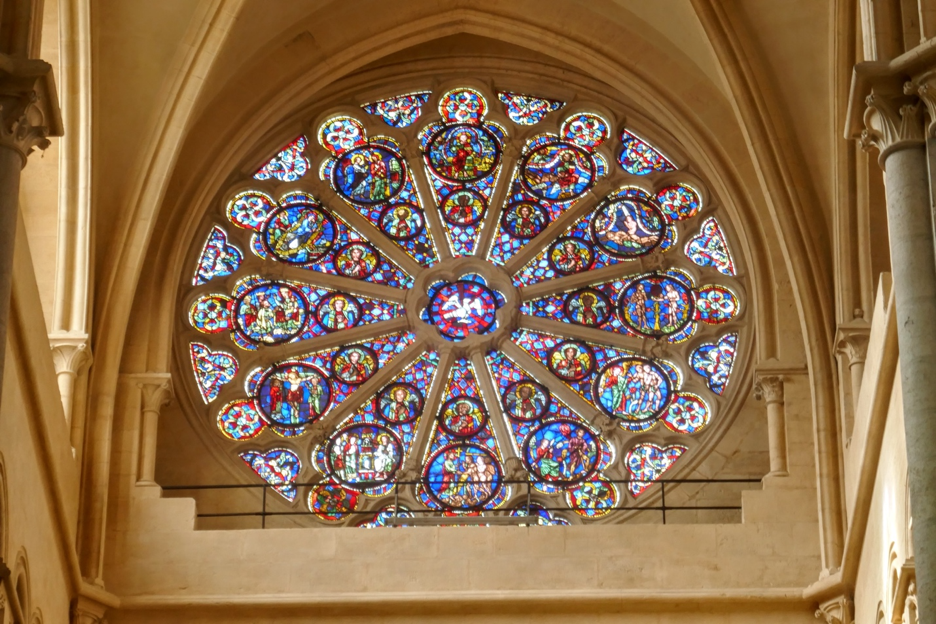
Presqu’ile (press-keel), the land between the rivers, is Lyon’s shopping and cultural hub. Place des Terreau is the large square which the Hotel de Ville (city hall) and the Musee des Beaux-Arts (museum of fine arts) face.

The centerpiece of the square is an enormous fountain depicting Marianne, the Lady of the Republic, driving a four-horse chariot and leading the Lyon’s two great rivers to the sea. The fountain was created by the sculptor who designed the Statue of Liberty. It was originally intended for the city of Bordeaux which determined that it couldn’t afford the piece; but the mayor of Lyon was entranced and acquired it in 1891.

Cuisine is important in Lyon. The bouchon are traditional Lyon restaurants with limited menu, and are all over the center city. Originally they were run by “Lyon meres" (mothers) who prepared simple but refined food in a comfortable atmosphere. Classic local dishes that we try include:
Salade Lyonnaise: greens with fried bits of ham and a poached egg
Quenelles: souffle dumpling with veal fat, flour, eggs, spices, and 25% meat or fish
L’Andouillette de Veau: a tripe casserole with delicate mustard sauce
Pâté en croute au foie gras de canard et ris de veau: crusted pie with duck foie gras and veal sweetbreads
And at Les Halles de Lyon (a food market themed for renown local chef Paul Bocuse) we sample some of the best and biggest raw oysters we have ever had.

Another pride of Lyon are the exquisitely painted building facades depicting famous historical, fictional, and modern people.


Beaujolais
The Beaujolais wine region is an hour’s drive northwest of Lyon; just west of the Saone River in the foothills of the Massif Central Mountains. We start at the northern end, just south of Macon, where the better Beaujolais Cru wines originate (there are 10 designated Cru plots) and drive through the villages of Fleurie, Moulin-a-Vent, Saint Amour-Bellevue, Julienas, and Morgon. They are small, older, farming communities less than 15 km apart. Only Fleurie seems to have some newer, somewhat upscale housing. Still, all appear to be moderately prosperous.
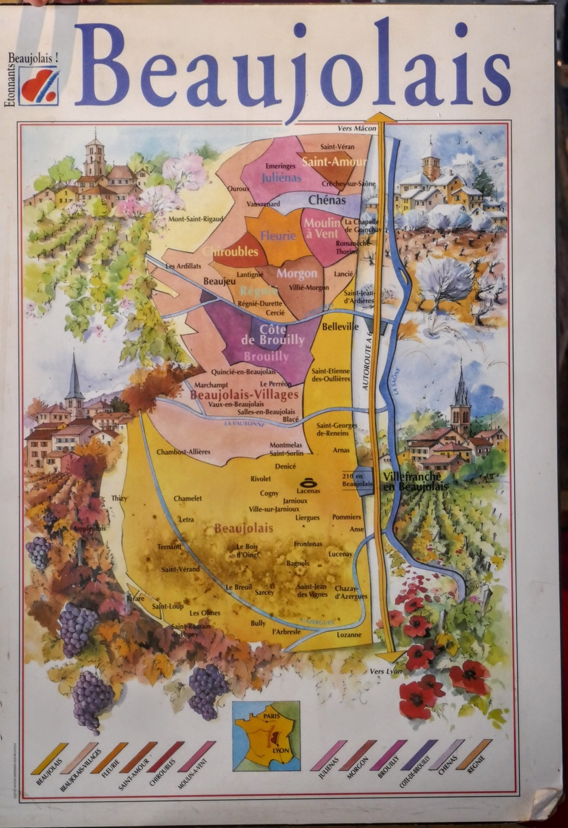
South of these designated Cru vineyards are the Beaujolais Villages then the generic Beaujolais area. The quality declines as one goes southward.
The land is hilly, and the vineyards are often very steep on the hillsides. Unlike Burgundy, corn, hay, and sunflowers alternate with the vineyards in the fields. And the vines are often trimmed to low bushes rather than neatly trellised.

Gamay is the primary grape here which produces a floral, fruit-forward wine with reasonable acidity, low tannins, and a light-to-medium body and alcohol level. The characteristics of specific Beaujolais wines are, of course, influenced by their terroir, especially in the Villages. The taste is of black cherries, plums, and can have some earthiness. It pairs well with many foods.
Most Beaujolais wine is produced through the semi-carbonic maceration method that highlights the fruity notes of the grapes. This method starts with a whole cluster fermentation using the natural yeast on the grapes; the pressure of the fruit begins to crush the grapes at the bottom of the vat. As the juice begins to ferment, CO2 is created forcing oxygen out of the tank which causes a biochemical fermentation reaction in the remaining grapes making them explode. After 4 to 8 days the juice is racked off, the grapes are crushed, and fermentation continues in the regular manner.
At Chateau de Corcelles we find a castle-fortress that was originally built in the 1400’s. It is now part of a family-run wine company with properties here as well as in Burgundy, Bordeaux and Chateauneuf du Pape. They specialize in wines from the Brouilly, Fleurie, and Morgon areas. Our visit was relaxed as there were few other visitors.
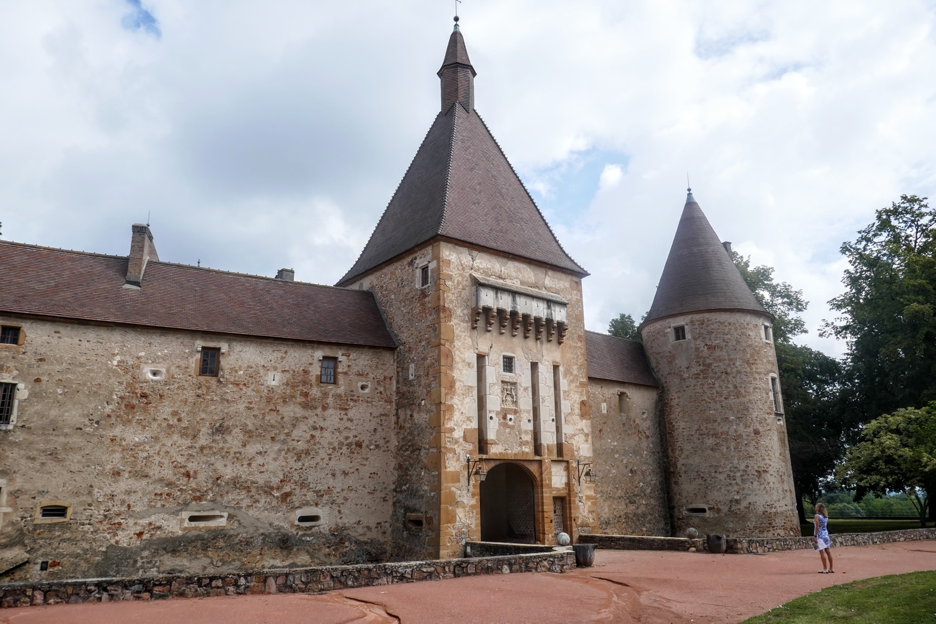
At Chateau de Julienas we were greeted by Anita, a gregarious woman of Hungarian heritage who has studied winemaking and worked at this property for 4 years. We taste in the wine production barn along with a British couple. The estate dates back to the 1200’s, but the current vineyards and owning family mark from 1907. Production focuses on Julienas, Moulin-a-Vent, and Fleurie.
Notes on Beaujolais Cru wines in order from what is listed in the literature as generally lighter to bolder:
Fleurie: generally described as more elegant and feminine wine. We find them to have some structure, layers of fruit, and a spicy finish as well. They are said to have aging potential for several years.
Brouilly: we find that these wines are tasty but fairly simple with some fruit but not as much depth of flavor as other Beaujolais; “subtle” is the polite term used. Some have a mildly spicy finish. Meant to be drunk young. There is also a Cote de Brouilly region just adjacent.
Julienas: we find these wines to have the best balance of fruit-notes, acid and light tannins. They are also said to have aging potential.
St Amour: we find these to be a little more tannic, spicy and rustic than the others. A light, floral version is also produced here.
Morgon: generally described as fleshy, tannic, powerful and earthy wines (for a Beaujolais). We find them to be nice with more meaty dishes.
Moulin-a-Vent: generally described as more complex, tannic and structured wines, and age-worthy.
Impressions of France
And so ends the vagabonds' excursion through the regions of France. Some overall impressions:
Amazing breads: baguettes, boules, croissants, and pastries. There seems to be a boulangerie on every street and “pain” offered at every meal.
Amazing wines: each region of France offers its own style and specialty: cabernet franc and chenin blanc in Loire; pinot noir and chardonnay in Burgundy; pinot gris and gewurtraminer (among others) in Alsace; gamay in Beaujolais, etc.
History: castles, chateaux, churches and abbeys, white limestone buildings, connections back to the 1100’s, the disruption of the Revolution
WWII: Normandy (in particular now with the 80th anniversary of the liberation) is caught up with the war and the liberation
Farmland: most of the country is rooted in agriculture, dotted with small villages with twisty streets and populations of a few hundred to a few thousand
Cities: there are few large cities (i.e. 1 million people and up) – Paris, Marseilles, Lyon, Lille, Toulouse, Bordeaux, Nice; there are only a few more with population approaching or above 500.000 people – Nantes, Toulon, Grenoble, Douai, Strasbourg, Montpellier, Rouen
Fresh vegetables and fruits especially at the farmers markets. The asparagus (white and green) are especially good. Selections change by the season as they use to in the States.
Meats and fish: OK but not great. Sausages are especially dull. Rotisserie chickens, though, are common and often tasty, and the duck is good in the Dordogne.
Strong coffee is an art and available everywhere
Language: important to make an effort to speak a little French. Many words in English originate from French or Latin so common root word vocabulary is helpful if you pay attention. Many people also speak or understand some English.
Style: Most people are conscious and careful about their clothes and appearance.
Clean and tidy streets: the streets are swept; windows cleaned; no litter; no homeless.




Comments